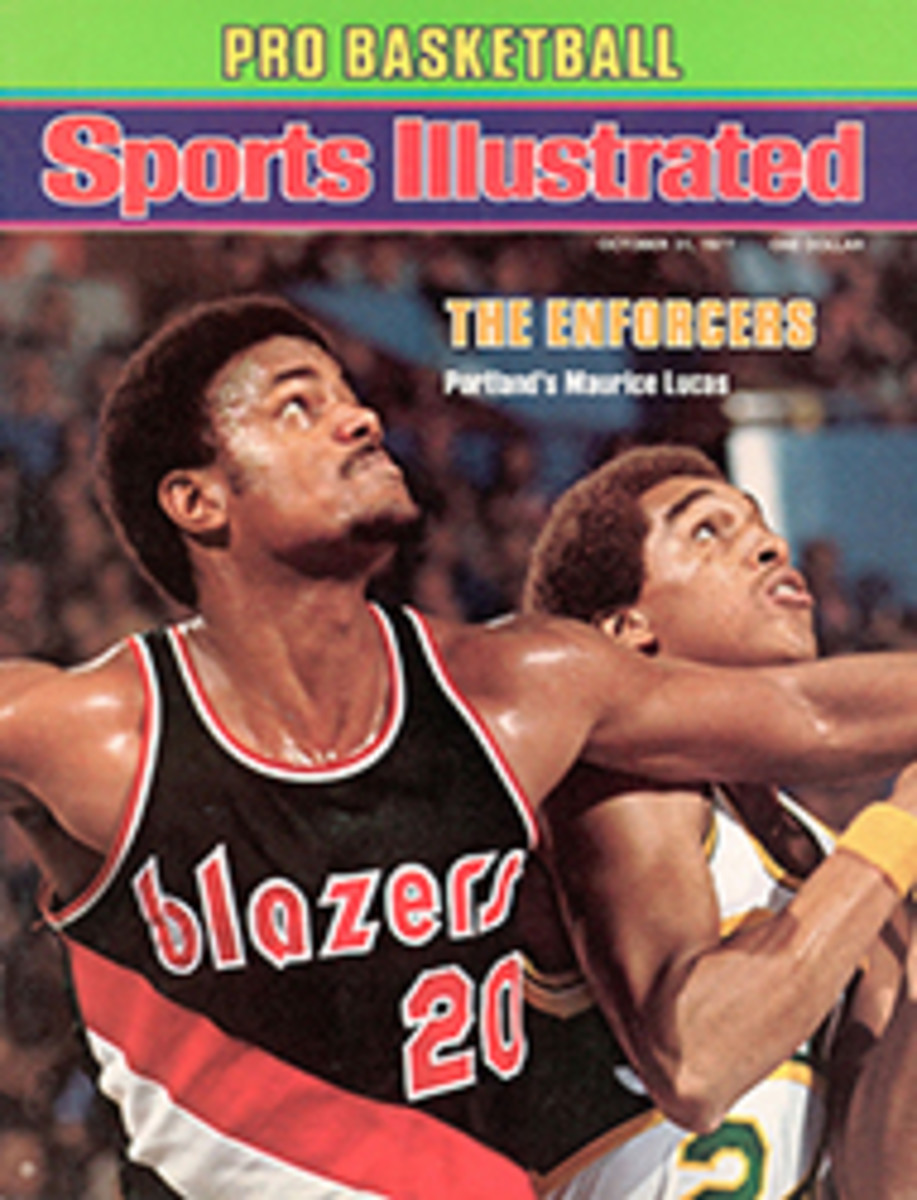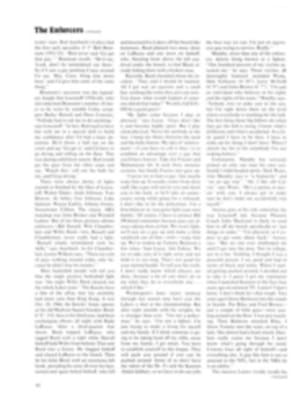
Welcome back, Scarface
His nickname wasn't Rocket or Boom Boom or Le Gros Bil, like some other members of the Hall of Fame. It was Scarface, for the more than 900 stitches that were sewn into his map during the 17 seasons he patrolled left wing in Detroit and Chicago. Scarface was only 5'8" and weighed maybe 160 pounds in full gear, but he was the NHL's career penalty-minute leader until Bryan Watson rubbed him out two seasons ago. Scarface retired in 1960, then four years later he unretired and rejoined the Red Wings. NHL President Clarence Campbell called the return of Scarface "a black day for hockey." True to his old form, Scarface, at age 39, was second in the NHL in penalty minutes that season—and then Terrible Ted Lindsay finally retired for good.
The Red Wings have not been the same since Lindsay hung up his skates and Gordie Howe had to go it alone. In fact, since Lindsay's retirement they have made the Stanley Cup playoffs just once in 12 years, a record for futility unmatched in hockey. During the drought, owner Bruce Norris hired and fired general managers and coaches as frequently as Ford turned out a new model. Last March, at a time when the once-proud Red Wings had the worst record in the NHL, Norris fired another general manager and hired Lindsay, long an outspoken critic of the bumbling Detroit operation, to replace him.
Lindsay watched the Red Wings for a few games and verified what everyone in hockey had known for years: the Red Wings played with the verve and oomph of a sorority-house team. They did their checking at the bank, not on the ice. Lindsay said he would change that.
All summer long Ol' Scarface showed up on billboards and on the covers of season-ticket sales come-ons, wearing a scowl and a T shirt that read AGGRESSIVE HOCKEY IS BACK IN TOWN. The club's postage meter spit out the same slogan, and it was also used—punctuated by some Batman-style "crashes" and "kabooms"—as the Red Wings' television promo. In keeping with his image, Lindsay hired such hatchetmen as Dave (Killer) Hanson, who had a role in the movie Slapshot, and Steve Durbano, who had left a trail of blood in four NHL cities.
When the Red Wings opened their season two weeks ago against the Toronto Maple Leafs, it was only natural to expect a hockey show resembling a gory scene from Slapshot. Certainly there would be brawls during the pregame warmup and high sticks during the national anthem. So, did the crowd of 12,872, some 3,000 more than last season's average "announced" attendance, see the expected blood? Violence?
Why, there wasn't even one fight. Instead, a fast little winger named Paul Woods, just drafted from Montreal, dived all over the ice blocking shots and tracking down loose pucks, and his fellow Red Wings played with a flair unseen since Lindsay departed in 1965. Trailing 3-1 with six minutes to play, Detroit rallied for two goals and tied Toronto 3-3.
"That's just what 'aggressive hockey' means," said the enthused Lindsay. "Backchecking, forechecking, playing the man, skating, passing, hustling and fighting for the puck. Sixty minutes of effort from players with some guts. All those things these fans in Detroit haven't seen for years."
One thing the people in Detroit had not seen in four years was a victory over Montreal, and last Thursday night the Red Wings came within 16 seconds of producing one. Unfortunately, they had to settle for a 2-2 tie, but the crowd of more than 12,000 saluted the effort by the Red Wings with several long ovations. Best of all, though, the Red Wings weren't playing like pushovers anymore.
"I don't care what people thought Ted Lindsay was doing," said Left Wing Dan Maloney. "He's got people talking about the Red Wings, something no one has done for years. Lindsay was a tough player, sure, but he's also one smart man."
During his retirement, the 52-year-old Lindsay made a name for himself in the Detroit business community. In partnership with former Red Wing teammate Marty Pavelich, he owns a plastics company in suburban Dearborn and also is a manufacturer's representative. He is a conservative businessman who dresses in Brooks Brothers suits, but one day he cleaned the floor in his plant on Labor Day himself because it was "messy" and because "These days you can't get people to do it for you."
The proud Lindsay has always been intensely loyal both to the Red Wings, for whom he played for 14 seasons, and to Detroit, where he has lived since 1944. And Lindsay kept in touch with hockey during his retirement. He still skates three times a week in a league where the games are played at 7 a.m. For fun, he coached at Detroit Country Day School and at Hillsdale College. For three seasons he served as color man on the NBC telecasts, and he always came to the defense of the aggressors. "That's the way to lay the lumber on him," he would say. He also regularly attended Red Wing games. "My company used to have 16 season tickets," Lindsay says, "but the last couple of years we cut down to four. We couldn't even give tickets away to see those sleepyheads."
How bad were the sleepyheads that Lindsay inherited? Last season, after more than a decade of crackbrained trades, terrible drafts and inept management, the Red Wings hit rock bottom, finishing 91 points—or 45½ games—behind Montreal and had the fewest victories (16) and goals (183) in the league. Maloney, Detroit's only stand-up-and-be-counted player, broke a shoulder blade on Dec. 23, and the Red Wings won only four of 46 games the rest of the season. In one late-season stretch of 81 power-play opportunities, they were outscored 6-1 by the penalty killers. The crowds, which were always SRO in the salad days of Lindsay and Gordie Howe—the Red Wings finished first from 1949 to 1955 and won four Stanley Cups—dropped to an announced 7,500 a night. "There were too many nights when we announced more than 8,000 and there were less than 5,000 in the building," says Lindsay. Worse, the Olympia, a decaying, 50-year-old building, was in a depressed neighborhood few people dared visit. In all, the Detroit Red Wings lost $2.6 million in 1976-77.
This was the mess Lindsay inherited. He fired two scouts and inspected the junior amateur players himself. The local press urged Lindsay to bring the Howe family, which had been sent packing en masse by a previous Red Wing administration, back to Detroit. "That would have been the easy public-relations move," says Lindsay, "but not the right move for what I'm trying to do. I'd love to have Mark, but the cost was too high. Anyway, there can be only one boss."
Lindsay tried to make trades, only to find that "you have to have something someone else wants." In Lindsay's case, Detroit had two things every other team wanted: the combative Maloney and the Red Wings' No. 1 pick—the first overall—in last June's amateur draft. Lindsay kept Maloney and the draft choice, selecting Center Dale McCourt from St. Catherine's. He also signed a batch of pugnacious free agents and acquired Goalie Ron Low from Washington, although the compensation, to Lindsay's chagrin, was Center Walt McKechnie, Detroit's top scorer last year.
Says Lindsay, "We can't contend with Montreal overnight. We know that. Right now I'm stuck with a lot of big contracts. What I promised was effort, and now we have competition at positions." The Wings had long closed their eyes to college kids and particularly to Americans. For instance, World Hockey Association MVP Robbie Ftorek, a Boston native, was rudely released after a short trial. Lindsay held a tryout camp, and 83 players came from such places as Replin, N.H. and Trail, B.C. Some 27 were held over for the regular camp, which opened with 82 players. "My owner is willing to spend anything to get a winner," says Lindsay. "I don't know the exact figures, but I do know that Montreal, Philadelphia and Detroit will spend the most on their organizations this season. The Canadiens and Flyers have done it this way for years. Check their records."
Not everything has gone smoothly. Lindsay ran into some typical Red Wing confusion last April when he announced that Larry Wilson would be rehired as coach, only to discover that the previous administration had hired Winnipeg's Bobby Kromm, effective with the termination of Kromm's Winnipeg contract in June. Kromm showed up and got the job, and Wilson took over the farm team in Kansas City. For now, Lindsay and Kromm claim to "think alike." Most important, say the players, Lindsay has stayed away from the dressing room, making it clear that Kromm is the coach.
Lindsay and Kromm hope the cornerstone of the new Red Wings will be McCourt, a graceful playmaker whose deft passes set up three goals in Detroit's 4-2 victory at Minnesota last Saturday night. McCourt isn't the only newcomer in Detroit. Ten of the 20 Red Wings played elsewhere last October. Lindsay's open-door policy made room on the roster for both a 12th-round pick, Center Rob Plumb, and a fourth-round choice, Defenseman John Hilworth. Eight of Detroit's 20 regulars have not reached their 23rd birthday. They have made a couple of youthful mistakes, but they also have hustled, checked and hit. No fights. No Hanson or Durbano, either. The former went to Kansas City, the latter was placed on the bench.
"This is the best hockey town in America," Lindsay says, "and the fans know what they're talking about. Marty Pavelich and I have been sitting up there with them for years, eating our hearts out the way they have. The difference now is that I'm being paid to do something about it. And I'm trying."
PHOTO
Lindsay never dressed like this when he was touring NHL penalty boxes.
PHOTO
Lindsay is rebuilding around Dale McCourt.

